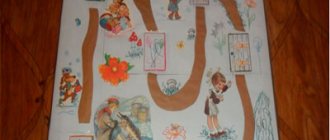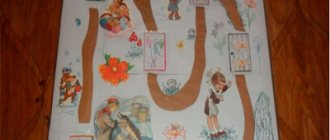Do-it-yourself tutorials for forming an air jet for kindergarten
Methodological development with manuals on the formation of an air jet “Working on an air jet is the key to quickly producing sound”
Author: Tatyana Aleksandrovna Savosina, speech therapist Place of work: MDOU “Kindergarten No. 14 “Hedgehog”, Saratov Description of the material: methodological development with 3 manuals on the topic “Working on an air stream is the key to quickly producing sound.” The manuals will be useful for speech therapists in their work when forming an air stream. The methodological development describes the role of the air stream in the production and assimilation of sounds, the main directions of the air stream, and provides methodological recommendations for corrective work on the air stream; The following is a description of 3 manuals on the formation and development of an air stream with photographs of the manuals. The manuals can be used when working with any age group, but they are more applicable when working with preschool children of the senior and preparatory groups. Goal: building work on the air stream, which affects the effective and rapid acquisition of pure sound pronunciation, achieving results in the field of speech correction. Objectives: 1. To attract the attention of teachers and parents to the problem of speech disorders in children. 2. Develop the strength, directionality, and smoothness of the air stream for quick and effective production of sounds. 3. Induce a positive and joyful emotional mood in class with the help of manuals, stimulate desire and interest in further correctional work. Timely acquisition of literate speech and clear sound pronunciation is of no small importance for the formation of a child’s full and harmonious development. Good speech is one of the main indicators of a child’s readiness to successfully master material at school. Deficiencies in sound pronunciation and other speech disorders can contribute to problematic learning and lead to a young student’s lack of self-confidence, which in turn will signal far-reaching negative consequences. Therefore, it is worth taking care of the child’s speech development in advance, the sooner the better. At present, unfortunately, the number of such children with speech defects, and especially with impaired sound pronunciation, is not only not decreasing, but, on the contrary, increasing. Speech is not our innate ability; it is formed in stages, and the process of its development depends on many reasons. We pronounce all the sounds of our speech, as you know, while exhaling. Accordingly, if the speech exhalation is incorrect, all sounds will sound blurry and unclear. Conversely, mastered correct exhalation - in the middle of the tongue - can normalize the quality of all speech sounds in children, as well as significantly reduce the time spent working on each sound. The production of a strong directed air stream is a necessary condition for sound production. You can work on the development of air flow and speech exhalation in a variety of ways: inflating balloons and soap bubbles, blowing a whistle, harmonica, pipe, blowing out candles. Such toys develop both the strength and duration of the air stream. The direction of exhalation is more difficult to adjust. Here, exercises such as blowing on a protruding tongue are used, where you need to ensure that the air stream goes down the middle of the tongue. The main directions for the air stream are identified: 1) the air stream passes straight through the center of the tongue. This direction corresponds to the pronunciation of most sounds: labiolabial (V, V', F, F', posterior lingual (K, K'. G, G'. X, X'), anterior lingual (T, T', D, D' ), whistling (S, S', Z, Z', C). 2) the stream passes upward through the center of the tongue. This direction is typical for the pronunciation of hissing sounds (Ш, Ж, ШЧ, Ш) and vibrants (Р, Р'). 3) the jet passes along the lateral edges of the tongue. This direction is typical for the pronunciation of stop-passive (L, L') sounds. Formation of an air stream for different groups of sounds: • Wide stream (for pronouncing hissing sounds); narrow jet (for making whistling sounds) • Warm jet (for making hissing sounds); cold stream (for making whistling sounds) • Scattered or directed air stream • Weak or strong air stream In the process of creating the correct air stream, you should adhere to these methodological recommendations: • Carry out exercises in a ventilated room. • The best results are achieved if the exercises are performed in a free body position, not sitting, but standing: the posture is straight, the chest is straightened. • Inhale deeply and calmly through the nose. Exhale through the mouth: light, smooth, long. • Monitor the direction of the air stream. • Exercises do not last longer than 3 minutes. • The amount and pace of exercises should be dosed correctly: blow intensely no more than 5 times. • Make sure that your cheeks do not puff out during exercise. • Exhaled air must not be retained. • Exercises are easier to do by counting. • For visual control at the initial stages, the use of a mirror is allowed. • The exhaled air stream is controlled using a cotton swab brought to the child’s mouth: if done correctly, the cotton swab will deflect. Work on the development of an air stream begins at the preparatory stage of the formation of correct sound pronunciation, along with the development of phonemic hearing and articulatory motor skills. I offer teaching aids that I have developed that will help produce a strong and smooth air stream. The manuals are colorful, attract attention and arouse children's interest in the activity. With such aids you can conduct a lesson in a playful way. 1. A cup of hot tea.
Aid for developing the duration and smoothness of the air stream, for developing a directed air stream.
Instructions: You need to cool the hot tea. To do this you need to blow steam. 2. Butterfly
Aid to produce a strong, long-lasting smooth air stream.
Instructions: Blow hard on the butterfly and it will fly away from the flower. 3. Hedgehog collects mushrooms
Aid to produce a strong, long-lasting smooth air stream. Instructions: Let's help the hedgehog collect mushrooms. But first you need to find them under the leaves. Blow on the leaves and help the hedgehog find all the mushrooms. We work on the formation of an air stream from the very first lessons, and the correction of sound pronunciation will be quick and timely.
We recommend watching:
Do-it-yourself cut-out pictures for preschoolers Methodological development of a thematic walk for children of senior preschool age Educational games in fine arts lessons Ways to implement the Federal State Educational Standard in fine arts lessons
Similar articles:
To the authors
DIY educational panel for kindergarten
Three themed games to automate sounds and develop the correct air flow
Three themed games to automate sounds and develop the correct air flow
“The child has a passion for the game, and it must be satisfied. We must not only give him time to play, but we must imbue his entire life with this game. His whole life is a game."
Makarenko A.S.
Play is not only a leading activity for preschool children, it is also an accessible, interesting, and exciting form of interaction with children. With the help of games, the development of both mental and mental abilities, as well as the development of speech components, is carried out in a more interesting and accessible way.
The games that I prepared for children were dedicated to the Halloween holiday. To make games I needed: paper, a color printer, laminating film, a laminator, scissors, thread or thin fishing line, and a needle.
Before I started playing with the children, I asked the children what they knew about this holiday and whether they celebrated it at home. Then I give the concept of what Halloween is, the attributes of this holiday, who gave rise to the development of this celebration and how it is celebrated.
Game "Pumpkins"
Goal: automation of set sounds, formation of phrases - sentences, development of attention, counting.
Progress of the game: The speech therapist shuffles the cards so that they are not in order, then puts them on the table with the words “... the pumpkins fell and broke in half, help me collect the pumpkins. For each number you need to find the same number of seeds.”
During the game, the speech therapist monitors how the child pronounces and automates the sounds that have already been made; if the child pronounces words incorrectly, the speech therapist corrects them. The speech therapist also pays attention to whether the child can form phrases and sentences; if not, the speech therapist helps.
The pumpkin cards are not mine, I found the pictures from the wonderful teacher #classesKonyakhina.
Game "Magic Web"
Goal: automation of delivered sounds, formation of phrases - sentences, development of the correct air flow, development of spatial representation.
Progress of the game: The speech therapist lays beetles on the web in advance (if possible, arrange the beetles so that the fasteners - threads are not visible), mixes the cards so that they are not in order, then asks the child to first blow on the web so that the bugs do not fly away – we blow 5 times, then blow so that, on the contrary, they all fly away at once.
During the game, the speech therapist monitors how the child pronounces, automates the sounds that have already been made; if the child pronounces words incorrectly, the speech therapist corrects them. The speech therapist also pays attention to whether the child can form phrases and sentences; if not, the speech therapist helps.
Game "Witch"
Goal: automation of delivered sounds, formation of phrases - sentences, development of the correct air flow, development of spatial representation.
Progress of the game: The speech therapist lays bats around the witch in advance (if possible, arrange the mice so that the fasteners - threads are not visible), mixes the cards so that they are not in order, then asks the child to first blow on the cobweb so that the bugs If they don’t fly apart, we blow at least 5 times, then blow so that, on the contrary, they all fly apart at once.
During the game, the speech therapist monitors how the child pronounces, automates the sounds that have already been made; if the child pronounces words incorrectly, the speech therapist corrects them. The speech therapist also pays attention to whether the child can form phrases and sentences; if not, the speech therapist helps.
The children, of course, enjoyed playing, fulfilling the basic conditions of the game; some children began to come up with their own rules. The games lifted our spirits and awakened the spirit of this mysterious holiday.
Afonshina Larisa Andreevna, teacher speech therapist-defectologist
- Summary of a subgroup speech therapy lesson on the production of air flow for middle-aged children, using ICT
- Speech therapy games for automation and differentiation of sounds
- Games in speech therapy classes for automation and differentiation of sounds
- Games for the development of phonemic hearing in children of primary school age
- Theatrical activities as a means of developing correct speech with children in a speech therapy group with special needs development
( 2 liked, average score: 3.00 out of 5)
Loading...
Card file of games for the development of breathing card file on speech therapy (senior group) on the topic
BREATHING GAMES
Game "Let's blow into a tube"
Task: to train a long-lasting air stream directed in the middle of the tongue.
Description. Take a deep breath through your nose, hold your breath, stretch your lips into a tube, stick your tongue between them, roll it up and blow into the resulting tube.
At first, you can blow on a curtain opposite, or on a narrow strip of paper attached to something and located in the direction of the air stream. It is necessary to ensure that the child exhales smoothly, for a long time, without puffing out his cheeks.
Game "Colorful leaves"
Task: to develop a smooth, long, directed exhalation.
Equipment: small stick, multi-colored dry leaves from different trees.
Description. At the level of the child's mouth, dry leaves of various shapes are suspended on threads. The child examines them, names them, determines the color, then slowly draws air through his nose (make sure that his shoulders do not rise) and blows on the leaves through a tube from his lips, without puffing out his cheeks.
Game "Guess what kind of vegetable"
Task: to train to take deep breaths through the nose, to teach the discrimination of smells.
Equipment: a dish with vegetables that have a distinct, special smell: onion, garlic, cucumber, dill.
Description. Recommended for children over 4 years old. The child examines, names vegetables, smells and remembers their smells.
To get a richer smell, an adult makes an incision on the vegetable; the dill can be crushed in your hands.
Then the child, blindfolded, must smell and recognize the vegetable offered to him by its smell. The adult makes sure that the inhalation is slow, smooth, deep, without raising the shoulders.
Game "Guess what kind of fruit"
Task: to train to take deep breaths through the nose, to teach them to distinguish smells.
Equipment: a vase with fruits that have a bright, special smell: orange, lemon, apple, pear.
Description. Recommended for children over 4 years old. An adult makes cuts on the fruit. The child examines, names, smells them, then, blindfolded, tries to identify the fruit offered to him by the smell.
Game "Pleasant Smell"
Task: to train the correct, deep breath through the nose, to teach to distinguish familiar smells.
Equipment: a vase containing peeled lemons, oranges, chocolate slices, and a fir branch.
Description. Recommended for children 3 years old. Children approach the vase, smell it and exhale saying: “How delicious!”, “It smells so good!”, “What a pleasant smell!”
Game "Focus"
Task: practice a long-lasting air stream directed in the middle of the tongue.
Description. The lips are in a smile, the lower lip is pulled down, the wide tongue is pressed tightly to the upper lip. Take a deep breath through your nose and, with your tongue in this position, blow on the cotton wool lying on the tip of your nose so that it flies vertically upward.
Make sure that you exhale onto your tongue and not onto your upper lip.
If the child copes well with this task, you can make it more difficult: gradually move the cotton wool along the back of the nose towards the forehead and try to blow it off in the same way.
Game “Blow cotton wool into the gate”
Task: to develop the ability to purposefully change the force of exhalation.
Equipment: cubes, construction set or other building material, small piece of cotton wool.
Description. An adult and a child build wide “gates” from cubes or other building material and place a small piece of cotton wool in front of them. The child, leaning forward slightly so that the air gets under the cotton wool, must blow on it with a long, smooth exhalation and get it into the “gate”. For this purpose, if necessary, you can change the direction and strength of the air stream. If the child copes well with this task, you can make it slightly more difficult by gradually making the “gate” narrow.
Game “Who will blow the cotton wool into the gate next”
Task: to train a smooth, continuous air stream, changing its direction if necessary.
Equipment: cubes, construction set or other building material, small piece of cotton wool.
Description. The game is played as a competition if the children do well in the previous exercise. On a flat surface, build two wide “gates” from cubes or other building material and place a small cotton ball at the same distance.
The players take a certain position: their lips are in a smile, the wide tongue is raised to the upper lip. Next, as if pronouncing the sound [f], the child tries to blow the cotton wool into the “gate” as far as possible. Violation of the position of the speech organs is not allowed: puffing out the cheeks, exhaling only onto the lips, pronouncing the sound [f] instead of [x].
Game "Storm in a Teacup"
Objective: develop a strong, targeted exhalation.
Equipment: glass of water, straw.
Description. A straw is placed into a glass of water. The child should take a deep breath through his nose, stretch out his lips with a straw and blow strongly into the straw so that the water begins to bubble in the glass. In this case, the cheeks should not swell, and you should not take an additional breath.
Game "Let's Honk!"
Task: train long, targeted exhalation.
Equipment: any small glass vials with a neck diameter of about 1 cm.
Description. An adult shows a child how to make a buzz using a glass bubble. To do this, the tip of the tongue should touch the neck of the bubble, and the bubble itself should touch the chin.
Next, you need to take a deep breath through your nose and then exhale strongly and for a long time onto your tongue in this position. Then the child tries to hum on his own.
Game "Boats"
Objective: to teach children to change the strength and direction of exhalation, to strengthen the muscles of the lips.
Equipment: basin with water, paper or light wooden (plastic) boats, small flag.
Description. The child (or children) sits near a basin of water in which boats float. The adult offers to take a trip to another “city”, indicated by a flag on the other edge of the pelvis. To do this, the child must gently blow on the boat, trying to bring it to the other side of the pelvis in the place where the flag is. If necessary, you can change the direction and force of exhalation, but maintain a certain position of the speech organs: lips are stretched, as for the sound [f] - for a smooth exhalation, extended like a tube - for a strong exhalation.
Game "Fly, airplane!"
Task: to develop a long, targeted exhalation, to strengthen the muscles of the lips.
Equipment: paper airplanes made together with the child.
Description. The game is played as a competition, in pairs. The airplanes are placed on the edge of the table. The players sit opposite them. At a signal from an adult, they must, with one exhalation, without taking an additional inhalation, move their airplane as far as possible along the table.
Game "Inflate the toy"
Task: to develop a strong, long, continuous exhalation.
Equipment: loose balloons or small inflatable toys.
Description. The child must inflate the balloon or toy, exhaling air smoothly and for a long time into the hole. Inhalation is carried out through the nose and lips with a tube.
Game "Birds (Butterflies)"
Objective: strengthen the lip muscles, develop a directed air stream.
Equipment: figurines of birds or butterflies, carved and brightly painted.
Description. “Birds” (“butterflies”) are planted on the edge of the table. Two players compete to see who can move their piece as far as possible along the table surface. Before starting the game, take one deep breath through your nose; you are not allowed to take an additional breath. Instead of the table surface, the figures can “fly” on strings, also with the help of a strong, directed exhalation.
Game "Spinner"
Task: to develop exhalation, strengthen the muscles of the lips.
Equipment: first a paper, then a plastic pinwheel.
Description. The child takes a deep breath through his nose, then exhales forcefully onto the moving parts of the toy to set them in motion. First, the child is offered a paper pinwheel, since it requires less effort, then a plastic one.
Game “Fly, Dandelion!”
Objective: to develop a long continuous air stream, strengthen the lip muscles.
Description. The child picks a dandelion, takes a deep breath through his nose and tries to blow away all its fluff with one strong, continuous exhalation. Intermittent exhalation of air or additional inhalation and exhalation are not allowed.
Game "Make a Wish"
Task: to develop a strong, directed exhalation, strengthen the muscles of the lips.
Equipment: sand set, small cake candles.
Description. An adult invites the child to prepare for his birthday or New Year and practice blowing out candles. The child himself makes “Kulichiki” (“cakes”) from sand, into which candles are then stuck in accordance with the child’s age.
Next, the child takes a deep breath and, with one strong, long exhalation, tries to blow out all the burning candles. At the same time, if the child wishes, he can make a wish to himself.
Game "Object trick"
Task: to train the strength and direction of exhalation.
Equipment: any flat surface (floor, table, etc.), light wooden or plastic objects (pen, pencil, spool, bead, etc.)
Description. The adult places any light object on the table, and the child takes a deep breath through his nose and blows strongly and for a long time on it. The object should roll away from the starting point in the direction of the air stream.
Game “Inflate, balloon!”
Task: to develop a long, smooth exhalation, to automate the sounds [s], [sh].
Description. Children stand close to each other in a small circle. Then they repeat the words after the adult: “Inflate, our balloon, inflate big, but don’t burst!” and move back, forming a large circle.
At the adult’s signal, “The ball has burst,” the children again narrow the circle and make the sound [s] or [sh] (depending on the children’s abilities), depicting the air coming out of the ball.
Game "Who takes longer?"
Objective: to develop speech breathing and voice strength.
Description. The game is played as a competition in pairs. Children stand facing each other.
At a signal from an adult, they simultaneously take a deep breath through their nose and begin to sing a certain vowel sound (A, O, U, Y, I) for a long time on one note. The one who lasts the sound longer without taking an additional breath is considered the winner.
Game "Blizzard Howls"
Task: to develop speech breathing, voice strength, and the ability to change it at the right time.
Equipment: plot picture “Blizzard”, audio recording of a blizzard at the beginning, at its height, at the end.
Description. An adult shows the children a picture, explaining what a blizzard is (this is a strong wind with snow), and lets them listen to the sound of a blizzard, when it begins, when it is strongest and when it subsides.
Then, at the adult’s signal, “The blizzard is beginning,” they quietly imitate its sound: ooh, “Strong blizzard,” change the strength of their voice to loud (but not scream), “The blizzard subsides,” again change the strength of their voice to quiet, “Blizzard passed” - they fall silent.
Before starting the game, children take a deep breath through their nose. The air taken should be enough for them to say “The blizzard has passed.”
Game "Ladder"
Objective: to train speech breathing, duration and smoothness of the voice, and the ability to change its timbre.
Description. The child takes a deep breath through his nose and, as he exhales, begins to smoothly, for a long time, stretch out any vowel sound, starting with a high tone of voice and gradually changing it to low and vice versa - from low to high.
Before the game starts, the adult shows the child how to do this and explains that the voice seems to go down and up the stairs.
Games to develop speech breathing
Games to develop speech breathing
Games to develop speech breathing
Games to develop speech breathing
Recently, there have been many children suffering from speech disorders. They have a weakness in the force of exhalation and the duration of speech exhalation
.
Therefore, the development of breathing
is one of the first and very important stages of corrective action on children with speech disorders.
Speech breathing
- is the main source of energy in the formation of speech sounds.
Speech breathing
differs from physiological breathing in that it is arbitrary, inhalation is shorter, exhalation, on the contrary, is slow, intermittent, and subordinate to the pronunciation of the text.
The formation of speech breathing involves
, including the production of an air stream. The production of an air stream is considered one of the necessary and significant conditions for producing sounds: sounds are pronounced in the exhalation phase.
Respiratory
exercises are needed to strengthen the air stream,
develop
the focus of the air stream (blow with the lips or on the tongue,
develop
the duration of the air stream.
Breathing
exercises increase ventilation of the lungs, so
games
should be played in a clean, ventilated room. Make sure that the child does not become dizzy. As soon as the head dizzy, take a break, gradually day by day, increasing the duration.
Games to develop speech breathing
can be divided into three groups:
1. Development games
air jet force.
2. Development games
duration of the air stream.
3. Development games
purposefulness of the air stream.
Development games
air force
"Seasons"
.
Goal: development
strong smooth oral exhalation; activation of the labial muscles.
Equipment: boxes decorated according to the seasons: winter - snow - polystyrene foam, spring - a tree with birds, summer - butterflies, autumn - autumn leaves made of paper; straws.
"Sultans"
Goal: development
strong smooth oral exhalation; activation of the labial muscles.
Equipment: attach strips cut from colored bags or garbage bags and fastened together to a wooden skewer.
"Snails"
Goal: development
strong smooth oral exhalation; activation of the labial muscles.
Equipment: snails and fields printed and laminated
Development games
air blast duration
"Father Frost"
Goal: development of long-term
, smooth exhalation, activation of the lip muscles.
Equipment: candy boxes, confetti inside; A hole was drilled in Santa Claus's hat for a straw.
"Insects"
Goal: development of long-term
, smooth exhalation, activation of the lip muscles.
Equipment: printed and taped insects attached to pencils.







